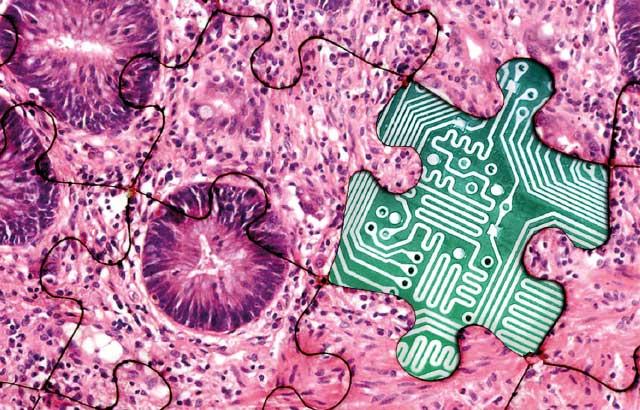
How to be a Digital Pioneer in Cancer Diagnostics

Digital pathology and artificial intelligence (AI) represent huge opportunities to improve our pathology and cancer diagnostic practice, but we can support healthcare decision-makers to take small steps to integrating these technologies.
In my last blog, I called for pathologists and hospital administrators to start working together, right now, to create a vision to integrate digital pathology (DP) and artificial intelligence (AI) into pathology services. Why the urgency? Firstly, as outlined in the Future of Pathology report, cancer numbers and requests for pathology testing are both on the rise.1,2 Numbers of pathologists, meanwhile, are falling.3 The introduction by the UK’s Department of Health of a new faster diagnostic standard* requires efficient testing turnaround times.4 The second reason is that we are starting to garner enough experience of DP to understand the potential of AI. We need to take advantage of what we know to decide what our pathology services will look like in the future. This is all very well, you may say, but how do we go about this? We can see the bigger picture, but that may not be enough to support healthcare decision-makers who need more detail as part of a shorter-term plan.
The response has to be to build a strong case for change. The people best poised to do this are highly passionate advocates. These may be supporters of DP and AI in particular, or experts in efficiency and effectiveness in general. Advocates can play a key role in creating consensus among influential colleagues by raising their awareness of the need for change. Raising awareness of the problem is every bit as important, indeed essential, as is making the case for change itself. The first step, therefore, is to find advocates. Talk to clinical and academic colleagues, and to hospital management to seek out enthusiasts, their ideas, and what they can contribute. Once you have found people who are willing to lend their voice and their energy, the next step is to equip them with evidence that makes the case.
One key element of any case for change is financial, but shaping our pathology services through the introduction of DP and AI is not only a question of cost savings. Through the change, we will need services that can ensure continued accuracy of diagnoses, while optimizing patient care and protecting the reputations of our hospitals. The contributions that DP and AI may bring include workforce optimisation, improved efficiency and quality in our services, and, importantly, enhanced patient safety. It would be difficult to show gains in all of these parameters at one time, across all elements of the pathology department, so I recommend first choosing one element or ‘use case’. For example, one ‘use case’ could be how DP might allow increased insourcing or outsourcing of diagnostic work; another could be using DP instead of a microscope in primary diagnosis from all pathological specimens from a particular part of the body.
Let’s take an example of how to make a case for the latter. After outlining the entire current workflow for the diagnosis of prostate cancer, for example, you can identify the reasons for investment in DP. Perhaps you want to reach out on a regular basis to a specialist pathologist in another center. By doing so, you may predict improved efficiency, as the need for off-site glass slide storage and transport should diminish, which in turn may free staff time to cover another overburdened area. Projected costs of the initiative need to be detailed, as well as whether this is a service that might be used beyond your own hospital, regionally, nationally or even internationally. Economically, would this change make more sense than doing nothing? In addition to economics, consider sustainability, affordability, quality, benefits, and risks. Might there be costs saved in terms of streamlining workflows and quicker report turnaround times?
You can read in more detail about how I and my colleagues at Leeds think we can make such cases, including potential areas of focus, in two publications: Future-proofing pathology: the case for clinical adoption of digital pathology – part one and part two . Also, see what other institutions are learning about benefits DP and AI can bring in terms of efficiency and effectiveness. Projected cost savings of a fully digital workflow in a routine histopathology context in a large healthcare organisation in the US were recently estimated at $12.4 million for an institution with 219,000 annual lab accessions over a 5-year period – however, these were only projected savings.5 Another center which was an early adopter of DP has shown how whole slide imaging has resulted in a >90% reduction in requests for glass slides leading to cost and efficiency savings in filing, retrieval and transport of glass slides.6 I anticipate we will hear of many more creative use cases for adoption of DP in the next few years.
I hope this information and these examples empower and inspire you to make a case for the adoption of DP and AI in your workplace. The future is in our hands – let’s transform cancer diagnostics together.
*The new Faster Diagnosis Standard will ensure that all patients who are referred for the investigation of suspected cancer find out, within 28 days, if they do or do not have a cancer diagnosis – further information on the policy is available on the NHS England website at www.england.nhs.uk/cancer/early-diagnosis
Follow #TheFutureOfPathology on Twitter, Facebook or LinkedIn.
About the presenter

Dr. Bethany Williams is a Specialty Doctor at Leeds Teaching Hospitals NHS Trust and the University of Leeds, and the Lead for Training, Validation and PPI at the National Pathology Imaging Co-Operative in the United Kingdom. She has published extensively in the fields of digital pathology patient safety, evidence based digital pathology training and validation and effective digital deployment. Her body of research earned her the Pathological Society’s medal for research impact, and she is regularly invited to speak at international conferences as an authority on the digital pathology evidence base, practical deployment and patient safety.
References
1. Cancer Research UK. Cancer incidence for all cancer combined. https://www.cancerresearchuk.org/health-professional/cancer-statistics/incidence?gclid=EAIaIQobChMI8tH08_7O5wIVRYXVCh3zhgPWEAAYASAAEgLz6vD_BwE&gclsrc=aw.ds#heading-Zero Accessed 9 June 2020.
2. Cancer Research UK. Testing times to come? An evaluation of pathology capacity across the UK. 2016. https://www.cancerresearchuk.org/sites/default/files/testing_times_to_come_nov_16_cruk.pdf Accessed 9 June 2020.
3. Royal College of Pathologists. Meeting Pathology Demand. Histopathology Workforce Census. London, UK: Royal College of Pathologists. 2018.
4. National Health Service. Clinically-led Review of NHS Access Standards. Interim Report from the NHS National Medical Director. NHS. 2019. https://www.england.nhs.uk/wp-content/uploads/2019/03/CRS-Interim-Report.pdf Accessed 9 June 2020.
5. Ho J, Ahlers SM, Stratmen C, et al. Can digital pathology result in cost savings? A financial projection for digital pathology implementation at a large integrated health care organization. J Pathol Inform 2014;5:33.
6. Hanna MG, Reuter VE, Samboy J, et al. Implementation of digital pathology offers clinical and operational increase in efficiency and cost savings. Archives of Pathology & Laboratory Medicine 2019;143(12):1545–1555.
Related Content
Leica Biosystems Knowledge Pathway content is subject to the Leica Biosystems website terms of use, available at: Legal Notice. The content, including webinars, training presentations and related materials is intended to provide general information regarding particular subjects of interest to health care professionals and is not intended to be, and should not be construed as, medical, regulatory or legal advice. The views and opinions expressed in any third-party content reflect the personal views and opinions of the speaker(s)/author(s) and do not necessarily represent or reflect the views or opinions of Leica Biosystems, its employees or agents. Any links contained in the content which provides access to third party resources or content is provided for convenience only.
For the use of any product, the applicable product documentation, including information guides, inserts and operation manuals should be consulted.
Copyright © 2025 Leica Biosystems division of Leica Microsystems, Inc. and its Leica Biosystems affiliates. All rights reserved. LEICA and the Leica Logo are registered trademarks of Leica Microsystems IR GmbH.


